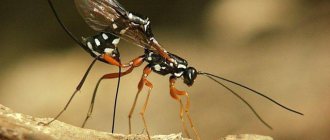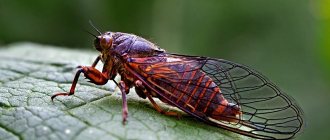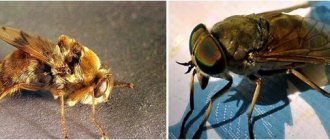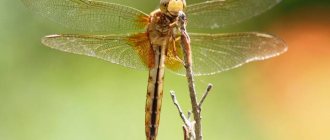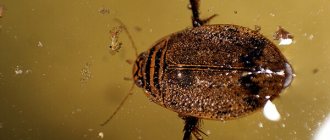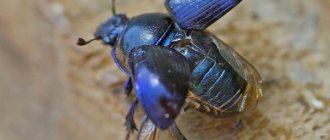The parasite (insect) is a beneficial parasite that monitors the number of pests in fields and gardens, preventing them from breeding in large numbers. The insect received this name because it lays eggs in the body of the victim, sitting astride it, while bending its elastic abdomen with the ovipositor well. The mechanism of nature for maintaining the numbers of many species of individuals is so intricate that it can be difficult for people to unravel it without harming themselves and the natural environment.
Insect riders: general information
The description of these parasites is quite interesting. The diversity of insect forms is combined with the abundance of their varieties. The largest species reaches 5 cm in length, and the smallest – up to 0.5 mm. Riders have long antennae, their bodies are very thin. They are often black with gold and red patterns. Most pests have colorless wings, but wingless specimens can also be found. Females carry an ovipositor on the back side, which can even exceed the length of their body.
Literature
- Viktorov G. A.
Ecology of entomophagous parasites / USSR Academy of Sciences, Department of General Biology. - M.: Nauka, 1976. - 152 p. - Kozlov M.A.
Main types of specialization of ichneumon waspers (Hymenoptera, Parasitica) to hosts // Host-parasitic relations. - L.: Nauka, 1972. - P. 5–17. - Tobias V.I.
Formation and development of the ability to paralyze prey in wasps and wasps (Hymenoptera, Apocrita) // Entomological Review. - T. 55, No. 2. - P. 308–310. - Whitfield JB
Phylogeny and evolution of host-parasitoid interactions in Hymenoptera // Annual Review of Entomology. - 1998. - Vol. 43. - P. 129–151.
The process of laying eggs
Such parasites are treasure hunters by nature. Distinguished by their excellent sense of smell, they run along dried up tree posts and look for walled-up larvae of longhorned beetles and golden beetles under the bark. At times, riders (insects) fly around the trunk in a curve, looking for the place where a large beetle larva was buried under the bark. And it’s even difficult to imagine how they can feel the larva through such dense bark.
Having found an area, the parasite settles on the bark of a pine tree and begins to pierce it with its ovipositor. Therefore, in most ichneumon races the ovipositors are enormously long; in some species they are even 7.5 times longer than the body. This is a whole drilling device. At first, the insect removes the “case” in which its “installation” was stored to the side, then it stands “on tiptoe” and slowly screws a thin sting into the bark. Along with this, the parasite is forced to spin, screwing the ovipositor deeper.
The drilling operation sometimes lasts several hours. Thanks to its special structure, the thin ovipositor easily passes through the thick bark of a tree, piercing into a hidden prey larva at a depth of 2-3 cm. Then the egg passes through this ovipositor.
Danger
The wasps are dangerous primarily for other arthropods, because parasitism leads to their death. This is the benefit of insects: they often fall prey to other pests that cause damage to human supplies, livestock, and agricultural crops. Equines, often being “super-parasites”, restrain the growth of their population. But is the ichneumon wasp dangerous for humans? The fear of these insects is not unfounded. Their body, like that of wasps, produces poison, so the bites do not go away without leaving a trace. But riders do not attack people just like that and do not lay eggs under human skin: they attack solely for the purpose of self-defense.
The poison is especially dangerous for those who have individual intolerance to the substances included in its composition. In this case, the bite can provoke a dangerous condition - anaphylactic shock. Even in the absence of hypersensitivity to the ichneumon ichneumon venom, soreness and swelling appear on the skin, which lasts for an average of three days.
Prevention from attacks by wasp wasps - careful behavior. If an insect is spotted nearby, there is no need to try to get to know it better or, on the contrary, actively drive it away with your hands. When visiting forests and meadows near water bodies, it is better to wear tight-fitting clothing that covers the entire body.
What to do if bitten by an ichneumon wasp? The action plan is universal for attacks by any insects:
But usually an encounter with an ichneumon wasp passes without any unpleasant consequences.
Riders are insects that are peaceful towards humans and never choose people as objects for parasitism. Their benefit lies in reducing the number of other pests. The only danger is their poisonous bite, which causes discomfort.
Types of riders (insects)
There are many varieties of such parasites: very small (less than 1 mm) and quite large (more than 2 cm). Some have an ovipositor several times wider than itself, while others have it tiny. There are individuals that destroy pest eggs, while other species parasitize living larvae, even overwintering in them. Some paralyze the victim before laying eggs, others do not.
Most adult insects feed on flower pollen (phacelia, dill), nectar, hemolymph of the victim, or sweet secretions of aphids. Many species do not feed at all, since they have formed eggs that only need to be laid. Of course, the female lays the eggs, and only she has the ovipositor.
Peculiarities
The sizes of adult individuals range from 2 millimeters to 4 or more centimeters. The abdomen is elongated, in females it has a long ovipositor (sometimes up to 17 centimeters). The head antennae are also elongated. The wings of most representatives are well developed.
After mating, females lay eggs directly on the body of the future host. Sometimes in the body or near the prey insect. Some larvae are selective in choosing a host, while others parasitize various insects. The death of the host occurs before pupation, less often after spring awakening. The rider injects special viruses into the victim’s body to subdue the immune system. And at the same time he diligently provides himself with fresh food.
The viability of the host is preserved, even if only a tenth of the mass of its internal organs remains intact.
Food includes caterpillars, beetles, ants, and wasps. Less common are spiders and scorpions. There are species that parasitize tahini flies. This is the so-called secondary parasitism.
Adult equestrians are active at night and are very sensitive to air humidity. They prefer to settle near bodies of water. Here they can be found on flowering herbs. The population increases sharply during rainy summers.
The average lifespan of adults is from three to ten months (in the case of wintering in the adult stage).
Eulophus
Such a parasitic ichneumon is an external group insect of the winter moth caterpillars, some specimens of butterflies, the ancient moth, leaf rollers, cutworms, moth moths, fruit moths, and others. At different periods, the death of winter moth caterpillars was noted at 27-37% from this parasite.
The size of an adult eulophus is no more than 2 mm. His body is silver in color. The ichneumon pupae overwinter in groups near the remains of the larvae, on fallen leaves, and rarely in the surface layer of soil under wood.
Beneficial ichneumon insects fly out of cocoons after overwintering, in the second half of May, at the stage of mass flowering of cherries, pears, mid-season varieties of currants, apple trees, cherries and plums. The flight of the parasite lasts approximately 2 weeks and ends at the beginning of the summer season. Eulophus are fed with nectar from weeds and flowers of fruit crops in garden plots. Since the winter moth caterpillars are absent from the garden at this time, the insects look for the larvae of other pests (leaf rollers, cutworms) and infect them.
By August, the larvae of the new generation have already finished feeding, pupate, firmly attaching themselves to the leaf, and after leaf fall ends, they move to the winter hut in fallen leaves or make their way into the surface layer of the earth.
Harm and benefit
By attacking pests of trees and plants, riders provide significant assistance in their extermination. Some species of these beneficial insects are even protected by the state as valuable helpers. They control the number of harmful insects, thereby establishing balance in nature.
Thanks to the work and active participation of parasitic riders in the destruction of harmful insects, agricultural workers and ordinary plot owners can reduce the use of toxic substances and chemicals in their beds. This has a positive effect on the quality of the harvest and the environmental situation.
Often riders can be found in warehouses of grain and bulk products. There they look for their victims - barn worms and food moths. In rare cases, if they fail, they can lay eggs in food products, which will lead to damage to the goods and damage to humans. But, given the number of pests destroyed, minor sabotage on the part of the parasitic rider will not spoil its image in the eyes of people. Therefore, when you see these strange insects with a long sting-tail in your garden or garden, do not rush to destroy them.
Panisk
These are large parasitic insects. The riders look like huge red mosquitoes, they fly into the light of a lamp and are distinguished by short ovipositors. 40 species of nocturnal moths parasitize caterpillars, including winter worms and cutworms, which cause considerable damage to winter crop plantings. They attach 3 eggs to the back of the caterpillars, and the larvae soon hatch from them and press tightly against the pests until the period when they need to weave a pupa and pupate.
Preventing an attack
The main prevention of a rider attack is considered to be careful behavior in nature. You should not come into contact with the parasite, try to catch it or kill it. When getting ready for a picnic or to a pond, you should wear thick clothes with long sleeves. It is better to treat children's skin with repellents, which will also protect the baby from bites of mosquitoes, other wasps, and midges.
Wasps are parasites that are harmless to humans and attack only insects. Fertilized females hunt for caterpillars, beetles or other wasps to lay their eggs. The hatched larvae are very voracious and can completely destroy the prey in just 5-6 days.
Source
Rissa
This species of riders has a large ovipositor. They infect pests that feed on wood. The parasite is also common in Russian forests. The insect is black in color with yellow stripes on the abdomen and spots on the chest. They have a well-developed sense of smell, which helps them detect longhorned beetles and horntail beetles that live under the bark of a tree in a recess of several centimeters. The ichneumon ichneumon (insect) drills a hole in the bark for a long time. Risses lay eggs directly into the passage eaten by the horntail larva. The larvae of these beneficial parasites first feed on the host's hemolymph and then consume internal organs.
Nutrition
The terrible methods of feeding the larvae of such creatures are already clear. By the time they hatch from the eggs and begin to develop, their parents have already made sure that they have enough food. After all, organisms infected with them do not suffer significantly immediately. They not only live, but grow, develop and feed, at first little noticing that a parasite is brewing inside them. But over time, a terrible fate awaits them.
For example, larvae from the braconid family, specializing in caterpillars, by the end of their formation leave only the skin of it, completely eating all the insides of their host. At first, developing parasites consume only fat, causing little damage to the host, but then vital organs are used.
One way or another, absolutely all species of equestrians are parasitic. But it is interesting that adults in some cases do not eat anything at all. However, others still need food. In this case, the rider feeds either on the secretions of other insects, or on nectar or pollen of plants.
Aphelinus, aphidiid, aphidius
They are small parasitic parasites mainly on aphids. When an insect detects an aphid, it tucks its abdomen between its legs, quickly pierces it with its ovipositor and jumps away so that it does not spray it with the protective secretions of its tubes. Aphelinus lay only 1 egg in aphids. Their larvae form in it, and over time it turns into a mummy.
Popular message topics
- Profession Nurse
A nurse (nurse) is a person with a secondary specialized medical education, a specialist in the field of nursing. This is a profession that is very difficult to underestimate, no doctor can handle it, - Environmental education
The relationship between man and the environment plays an important role in a favorable environmental situation on our planet. As a result of severe air and water pollution, life on earth is in danger of extinction. - Sharks
Man has been fascinated and interested in the sea and its inhabitants since ancient times. Many people liked the waves splashing on the shore and the beautiful blue water visible in the distance. Still, there were no such brave souls who agreed to go to the open sea,
Ageniaspis
Considered one of the original designs. The parasite (insect) specializes in infecting the apple moth egg, however, it does not mature for a long time, but waits for the caterpillar itself to develop. Then from this egg many twins appear. From the eaten larvae, 150-200 ageniaspis are hatched.
The record holder for fertility is plastigaster. It mainly parasitizes the Hessian grain fly. The female infects both young larvae and eggs, laying up to 3000 eggs during her life.
No less popular is encarsia, which lays its eggs on the larvae of the greenhouse whitefly. Almost all greenhouse agricultural companies propagate it.
Brazilian wandering spider
Also known as Phoneutria, Brazilian wandering spiders are venomous creatures that live in tropical South America and Central America. In the 2010 Guinness Book of World Records, this type of spider was called the most poisonous spider in the world.
The venom of this genus of spiders contains a powerful neurotoxin known as PhTx3. In lethal concentrations, this neurotoxin causes loss of muscle control and breathing problems, leading to paralysis and eventual suffocation. The bite is of average pain, the venom causes immediate infection of the lymphatic system, entry into the bloodstream in 85% leads to heart failure. Patients feel wild rigor during life, sometimes causing priapism in men. There is an antidote that is used on par with antibiotics, but due to the severity of the damage to the body from the poison, the detoxification procedure is essentially equal to the victim's chance of survival.
What do beneficial parasites usually eat?
Most species of such insects do not eat meat. The adult rider (insect) eats the nectar of flowers and hunts to continue its lineage. There are mature individuals that do not feed on anything at all. However, parasites are very fond of drinking, gathering near lakes and feasting on dew. They exist for no more than 2 months, some of them are evening or nocturnal insects. But at the same time, the favorite and main food of riders are:
- mealybugs;
- cicadas;
- sawflies;
- scale insects;
- aphid;
- bedbugs;
- pest butterflies;
- flies;
- whiteflies;
- burners;
- beetles;
- blood aphid.
Many will be interested to hear the answer to the question: “Is the insect rider dangerous for humans?” Absolutely not, and on the contrary, these parasites play an important role in nature, protecting garden plots with fruit trees and vegetables from the invasion of various pests.
What to do if a wasp bites a person?
In some cases, hypersensitivity to the sting of a parasitic wasp wasp has been recorded. An allergic reaction occurs in young children and people with reduced immunity. To prevent anaphylactic shock or angioedema, it is recommended to provide first aid to the victim in a timely manner.
Symptoms and consequences
Most often, a wasp sting does not show up on the skin. But with a strong concentration of toxins that the insect injects during an attack, a slight redness appears. Itching and swelling may also occur. The most dangerous consequence of an encounter with a rider is considered to be scratching the wound. In this way, a person can independently introduce an infection. Symptoms of infection are swelling and tearing of the stung area, the formation of an abscess, and a rash.
If redness does not go away after 5 days, you should consult a doctor. To determine the diagnosis and prescribe treatment, the victim is given a referral for a scraping from the bite site, a general blood and urine test.
First aid
After a wasp attack, you should wipe the bite site with an antiseptic. Fukortsin, Miramistin, hydrogen peroxide or alcohol (vodka) are suitable for this. If pain occurs, you can take analgesics and antispasmodics. To prevent the development of swelling, redness and rashes, anti-inflammatory medications are needed.
Allergic reaction
An allergic reaction is rare because when a long-tailed wasp stings, it injects a minimal amount of toxin that is not dangerous to humans. But there is always a risk of developing severe swelling or hives. Young children need to be especially closely monitored. If signs of intolerance to poison appear, you should urgently take antihistamines (Suprastin, Loratadine, Zodak), and then seek help from a doctor.
Sources
- https://www.syl.ru/article/211515/new_naezdnik-nasekomoe-obschie-svedeniya-opisanie
- https://Dezoff.ru/nasekomye/osa-naezdnik/
- https://givnost.ru/naezdnik-nasekomoe-opisanie-osobennosti-vidy-obraz-zhizni-i-sreda-obitaniya-naezdnika/
- https://alternativa-mc.ru/infekcii-lechenie/osa-parazit-naezdnik.html
- https://GdeKlop.ru/osy-i-pchely/naezdnik-s-dlinnym-hvostom/
- https://klopkan.ru/osy/osa-naezdnik-foto-i-opisanie-opasna-li-dlya-cheloveka/
- https://kursi-floristiki.ru/klopy/osa-naezdnik.html
- https://givotniymir.ru/naezdnik-nasekomoe-obraz-zhizni-i-sreda-obitaniya-naezdnika/
- https://animalreader.ru/chto-za-nasekomyie-naezdniki-i-kak-oni-vyirashhivayut-potomstvo.html
- https://apest.ru/osy/vidy-os/osa-naezdnik/
[collapse]
Care
The giant phalaenopsis is very demanding when it comes to indoor conditions.
Optimal conditions of detention
For good growth and normal flowering when kept indoors, it must be provided with favorable growing conditions:
- The optimal cultivation temperature is in the range of 22-30℃ with a mandatory daily temperature fluctuation of 5-8℃. The plant does not tolerate well if the room temperature drops below 15℃;
- Lots of diffused light, much more than most other orchid species. In winter, the orchid is placed on the brightest window, as it grows all year round;
- The required indoor air humidity is 60-85%. To maintain optimal humidity, you can use a humidifier or place the orchid pot on damp expanded clay;
- The plant loves good air circulation so that moisture quickly evaporates from the leaves.
If you create favorable conditions for the giant phalaenopsis, it will reward you with good growth and extraordinary flowering.
Here's another giant. Other photos and description of this specimen can be found here.
Advice! If the orchid is not growing well, pay attention to the lighting. The right location plays an important role in the health and well-being of the plant.
Replanting after purchase
After purchase, phalaenopsis is not recommended to be replanted. This can only be done if rotten roots are visible.
It is better to place the plant in diffused light, away from other indoor plants. At first, it is not recommended to water or feed it.
If no diseases are detected during quarantine, then after 10 days the plant can be placed in a permanent place and watered.
Watering and fertilizing
Like other types of orchids, giant phalaenopsis is very sensitive to watering:
- Water the phalaenopsis as the substrate dries. It is better to do this in the morning so that the water that remains on the leaves dries by the evening. Watering is carried out once every 7 days, and care is taken not to cause waterlogging of the substrate;
- To water, place the pot with the plant in a container filled with water to 2/3 of the height of the pot and leave to stand for 15 minutes. After the roots are saturated with water and have acquired a bright green color, the pot is placed on the surface for 30 minutes to allow the water to drain;
- A good outflow of water can be ensured by placing the pot at an angle of 35-40°;
- If there is insufficient lighting in winter, the regime of watering and feeding the orchid is reduced.
Attention! It is necessary to ensure that water does not accumulate at the growth point of the giant phalaenopsis, as this can lead to rotting of the orchid. Fertilizing is carried out with highly diluted fertilizer for orchids.
Fertilizing is carried out with highly diluted orchid fertilizer.
For phalaenopsis growing on different substrates, different types of fertilizers are used:
- On a substrate of living sphagnum moss, foliar feeding with fish fertilizer is used (0.1 teaspoon per 3.8 liters of water). In this case, you cannot use chemical fertilizers, this can lead to the death of the substrate;
- On a bark substrate, the plant is fed with ½-1/4 doses of orchid fertilizer.
Feeding is carried out during every third watering of phalaenopsis.
Stimulating flowering
To stimulate the flowering of giant phalaenopsis, the plant needs daily temperature fluctuations.
Optimal differences should not exceed 5-8 ℃: from 30-31 ℃ during the day to 22-23 ℃ at night.
Attention! The main condition for regular flowering of an orchid is optimal maintenance conditions and proper care.
Prevention of diseases and pests
In order for the orchid to grow healthy, it is necessary to ensure that water does not fall on the leaves when watering and does not stagnate in the leaf axils, as this can cause bacterial rot.
Rotting of the growing point is especially dangerous. To prevent this from happening:
- After watering, the water from the surface of the leaf must be blotted with a paper napkin;
- To prevent water from accumulating at the base of the leaves, it is better to place or hang the container for orchids at an angle of 40-45o.
On rainy days, after watering, you can spray the plant with a fungicide to prevent rotting.
The harmfulness of creatures
It's time to figure out whether the wasp is dangerous for people. No, rather the opposite - these insects bring considerable benefits to humans, ridding plantations of bark beetles, voracious caterpillars and spiders. Individuals help protect forests and agricultural lands, maintaining natural balance. Many homestead owners specifically attract creatures to their territory to combat harmful beetles and spiders.
Iridescent wasps are able to parasitize a huge number of pests, killing them and thus preventing damage to crops. Protecting food barns and agricultural fields with their help reduces the volume of toxic chemicals, which significantly improves the environmental situation.
It is worth remembering, however, that some species of ichneumon ichneumon bite quite painfully, but their bites pose a potential threat only to allergy sufferers and children.
Basically, this kind of damage does not pose a threat to humans and is completely harmless, so you can safely attract creatures to fight the annoying garden pests.
